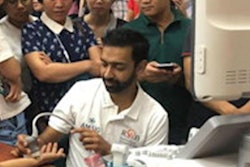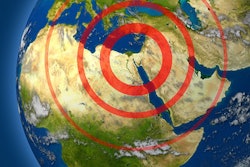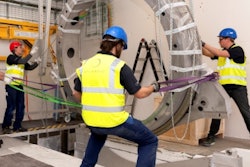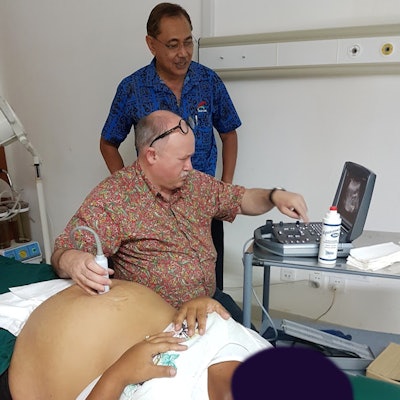
An Australian-based radiology charity is taking sustainable imaging expertise to doctors and patients in the Asia-Pacific region, and now it hopes to grow into a global group over the next five years.
Established in 2010, Radiology Across Borders (RAB) has gradually expanded its reach to include seven nations, but is calling for more volunteers and corporate funding as it takes on larger projects to support long-term radiology training. It also seeks to establish an imaging infrastructure in some of the world's most impoverished countries. Furthermore, the charity is looking to harness the skills of Europe's radiologists as it transfers projects to other regions in the medium term.
The group's key focus is education, according to its organizers, as this is central to good healthcare and lets nations and individuals take control of their own future. Specifically, experts within the charity are designing a formal curriculum aligned to the needs of the recipient nations.
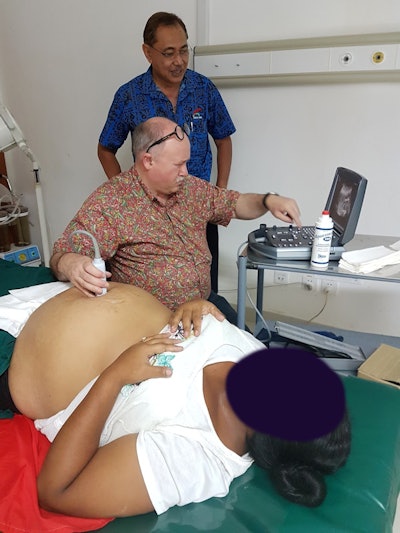 RAB's Dr. Glen McNally scanning a pregnant patient on a visit to Samoa in 2016.
RAB's Dr. Glen McNally scanning a pregnant patient on a visit to Samoa in 2016.Far from being based on random handouts, the charity's work is intended to provide long-term self-sufficiency for the region's local and trainee radiologists. RAB runs monthly educational teleconferences that are transmitted simultaneously to all seven nations from Samoa across to Laos and Cambodia, a distance that spans a six-hour time difference and also includes Fiji, Papua New Guinea, Vietnam, and Vanuatu.
The group has also undertaken 19 site visits among its network countries with teams of three or four radiologists and physicians to provide each nation with lectures and hands-on training with patients every year. In addition, it facilitates the provision of modern imaging equipment donated by the charity's sponsors to hospitals in the network.
The founder's vision
Co-founder Dr. Suresh de Silva, an oncological/body imaging consultant and conjoint lecturer at the University of New South Wales, explained his vision of the organization and his hopes for its future development in an interview with AuntMinnieEurope.com.
"I was born in Sri Lanka but grew up in the U.K. before moving to Australia. Having seen how good medicine can be in privileged countries, and how tough it can be in the developing world, I always wanted to give something back," he noted. "Fortunately, this conviction was shared by many like-minded radiologists."
The group began in 2010 with the aim to provide education and practical help in countries where no formal curriculum for radiology training existed, and where there might be three radiologists for up to 7 million inhabitants, as is the case in Papua New Guinea, or no radiologist at all for a population of 250,000, as in Vanuatu.
 RAB volunteer Dr. David Mitchell doing hands-on ultrasound training in Cambodia in 2016.
RAB volunteer Dr. David Mitchell doing hands-on ultrasound training in Cambodia in 2016.Over the past three years, as its work has become more publicized, RAB's membership swelled to a core group of 35 imaging specialists and 10 to 15 regular nonimaging support volunteers based predominantly in Australia and New Zealand.
Pivotal to projects past and present are Drs. Patrick Luckey, Glen McNally, Greg Briggs, Michael Curley, and Victor Mansberg, although many other radiologists from around the world, including Europe and America, have expressed interest. While the practicalities of logistics mean not all those who wish to volunteer their time can physically participate, de Silva believes the current teleconference programs and training curriculums under development for Asia-Pacific and Southeast Asia, will serve as templates that can be transferred to other global regions such as Africa in the future.
"We will need radiology volunteers from Europe within the next five years as we include different regions," he explained. "However, for now, in addition to radiologists, we are calling for other types of support volunteers, such as secretarial and administrative staff, videographers, and IT experts, as well as marketing staff, who can help keep programs running once they are set up and so that we can consolidate our work in the Asia-Pacific first, which is our priority."
Vital industry support
De Silva pointed to the generous help from RAB's main sponsor, Siemens Healthineers.
"This sponsor has set up a dedicated space on its webinar platform for the upcoming curriculum, provided financial and logistics support, and importantly shares the same ethos: Siemens' general manager for Australia and New Zealand has formally provided each of the company's 560 employees with three days of paid leave so that they can work pro bono for RAB," he noted.
Other significant partners include a law firm that helped to set up RAB as a company to obtain its charity status, and an accountancy firm that runs its books. Each partner works free of charge. De Silva and several other board members also spend many hours each week on the group's projects. In addition, the travel and accommodation costs for all international visits are paid for by the visiting radiologists themselves, who then work with local trainees for free.
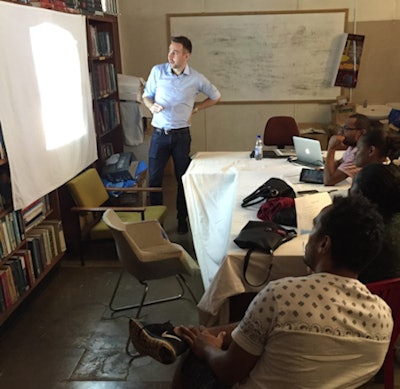 Dr. Glyn Llewellyn-Jones lecturing during a RAB site visit to Vanuatu in 2016.
Dr. Glyn Llewellyn-Jones lecturing during a RAB site visit to Vanuatu in 2016.While this type of voluntary work has functioned well until now, the organization required is currently too big to rely on volunteered hours alone, according to de Silva, and extra costs have obliged RAB to look for corporate funding to complement the support already provided by Siemens Healthineers.
This extra funding will cover the employment of a part-time administrator to oversee the projects and also purchase Radiology Integrated Training Initiative (R-ITI) licenses, which will form a core part of the specific curriculums under development.
Investment also will be required for developing bigger software platforms to host the specific training curriculums and for developing the infrastructure necessary for another of the group's key projects: Teleradiology in Disaster Events (TIDE).
"Disaster radiology is a very important area for development, given the increasing number of events. Despite this, it is done very ad hoc, with no global or even local infrastructure template," de Silva said.
The first part of the TIDE project was undertaken by RAB in 2016, with the support of the World Health Organization (WHO). This involved a needs assessment of Fiji, Samoa, and Papua New Guinea. The second implementation phase will begin mid-2017. The charity hopes to use TIDE's infrastructure to also provide assistance with day-to-day radiology within the nations, such as screening programs and second opinions.
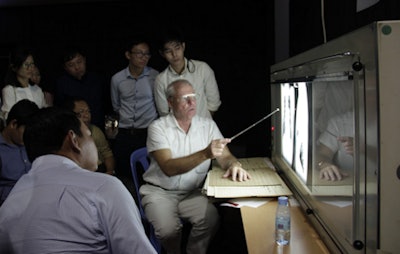 RAB's Dr. Jim Mullany holding a tutorial in Cambodia, 2016.
RAB's Dr. Jim Mullany holding a tutorial in Cambodia, 2016.In addition, RAB is looking to partner with other radiology colleges in different continents and with different specialties. Its latest collaboration is with the Australasian Society for Ultrasound in Medicine (ASUM) to focus on breast and ob/gyn ultrasound. The first program will be launched in Samoa in June 2017, and it will be introduced to other countries year by year. This program will involve online and hands-on training led by ASUM and RAB sonographers and radiologists who will visit Samoa during the course of the year.
"There is little or no access to image interpretation, and screening programs are nonexistent. Patients present with breast malignancies at a very advanced stage. Our goal is now to train local staff in breast mammography and ultrasound and eventually to set up the infrastructure to assist remotely using the TIDE template," de Silva said.
He also pointed to other areas of need, such as teleconference rooms to receive the educational programs. Such rooms exist in Hanoi hospital in Vietnam and in Fiji, but in other nations, access to teleconferences involves many participants trying to crowd around a single laptop.
"These countries do well with the limited resources they have, but local radiologists need training, equipment, and image transfer systems. Basic infrastructure is crucial," he noted.
RAB is already making a difference, according to de Silva, but its bigger plans to assist with education, infrastructure, and consultancy require more volunteers from other medical and nonmedical domains.
"RAB is very much a 'labor of love' for all group members; however, it is an experience that we all very much value, as it is both rewarding and unique. To expand our work, we need more like-minded clinicians as well as corporate sponsors," he said. "If radiologists believe they can potentially help us with our mission, they should look at our web page. Together we can make a difference."
For more details and to find out how to volunteer, visit the RAB website.




